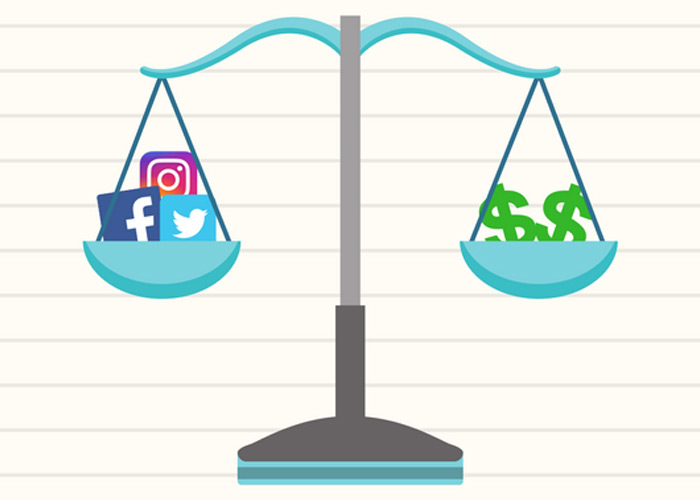Be honest: is your business actually getting anything out of its social media presence? Harsh question? Maybe so. But bear in mind how difficult it is for brands to wrap their heads around the Social Media ROI. If you are interested in social media marketing, keep reading this article to get familiar with the concept of ROI.
A Complete Guide to Social Media ROI
If the concept of social media ROI feels rather enormous, you’re not alone.
What is Social Media ROI ?
Social media ROI is the return on investment a company can expect to make from the time, money and effort the company spends on social media marketing.
Over the past several years, as social media has become more entrenched in various aspects of business operations, business executives have often questioned the dollar value of investing in social media.
Measuring the return on metrics such as engagement rate or customer satisfaction often feels like a guessing game.
Besides, not everything you do on social media translates directly into dollars and cents.
Yet at the same time, businesses need to be held accountable for the time and resources that go into their social efforts.
Also Read:
What Is Social Media Engagement ? Why is it so Important ?
Why ROI matters ?
There is a number of reasons why measuring social media ROI should be a priority in your business. Keeping an eye on social media revenue can help you to:
- Demonstrate the value of social media marketing to your company
- Prove that your social media marketing strategies are effective
- Identify areas of your strategy that are particularly successful to shift more budget towards them
- Pinpoint aspects of your strategy that aren’t working and fix them
- Support social media budget requirements
If you want to squeeze the most out of your valuable time to attract and convert customers via social, you need to define what you’re trying to get out of your presence.

How do You Identify Good ROI?
Determining the difference between a good social media ROI and a bad one can be challenging. After all, there’s no universal number that would stand for a desirable social media ROI and a revenue that’s sufficient to sustain your business might be too little to put you ahead of the game.
To understand how good your social media ROI really is, you need to benchmark it against the market. This way, you’ll know how much your competitors are investing in their social media marketing efforts, what they’re getting in return, and how your own revenue stacks up.
Monitoring your social media ROI in the context of the market has one more important benefit – it enables you to detect and act on bigger trends.
The social media landscape is constantly evolving: there are algorithm changes, seasonal campaigns and new competitors. All of which can impact your revenue. Keeping an eye on the revenue fluctuations within the market will help you determine whether the changes to your ROI fall within the benchmarks or if you’re the only one seeing an impact and should make strategy adjustments.
Also Read:
Best Social Media Platforms for Your Brand in 2021
Calculating ROI of Social Media
1. define the purpose of social media for your brand
When we think “ROI,” we often default to thinking about money. Yet not all brands are necessarily using their social presence to “follow the money.”
For example, raising brand awareness is a perfectly good reason to invest in social media.
You also have brands who are primarily concerned with customer service and community building.
2. Use Platform Analytics Tools
Many social media sites, understanding the need for marketers to measure their social media performance, provide built-in analytics tools for tracking engagement, likes, shares, etc. There’s Facebook Insights, LinkedIn Company Page Insights, and Pinterest Web Analytics to name a few.
Social media tools like these are handy at measuring your performance within the social media platform, but do little to show how your social media actions affect the bottom line or contribute to conversions, which usually happen outside that platform and on your own site.
3. Set actionable social goals
Below are some common yet specific goals for any given brand’s social campaigns:
- Email list sign-ups
- Contact form inquiries
- Trials
- Purchases
- Downloads of a whitepaper or eBook
Note that all of these goals are based on someone taking a measurable action that can be tracked.
Metrics like social shares, followers and general traffic are worth tracking but they shouldn’t be your main goals. Unless you’re focused solely on social media engagement and awareness, these metrics don’t drill down deep enough for assessing ROI.
In order to get the most accurate numbers for your social media ROI, it pays set your goals based on defined actions. Specifically, actions that convert a casual browser to a lead and ultimately to a paying customer.
Social Media ROI
4. Track your social media expenses
In order to figure out whether you’re getting a positive or negative ROI for social media campaigns, you’ll also have to measure how much you’re spending. That spend doesn’t just encompass money, though. Here’s what should be included in your ROI calculations.
- Time: Your time is valuable. Whether you’re a solo business or you have a social media team, add up the hours that go into a specific social media marketing campaign over a specified period of time. Don’t just use an employee’s annual salary, though, as they’re more than likely going to be working on several projects throughout the year. Measure this investment per-campaign.
- Content: Did you get a landing page written by a professional copywriter? Or maybe you outsourced status updates. These costs are easy to overlook but they certainly count. If you’re writing such copy yourself, that’s going to count toward your time investment.
- Social media tools: Using Facebook and Twitter is free, but if you’re using a social media management software, you need to add those costs in. Just like with the hours, you should calculate this on a per-campaign basis. So if your campaign lasts for one month, only add in the cost of a month of the software, not an entire year.
- Ad costs: If you’re running a Promoted Tweet, Facebook Ad or boosting a Facebook post, add in that cost as well. This is fairly easy to track as you set up your ad budget.

Social Media ROI Formula
Once you have your expenses calculated, you’ll be able to calculate your social media ROI for every campaign with this simple formula:
(Earnings – Costs) x 100 / Costs
Earnings are based on the value you calculated in the previous section. Your costs are the items listed above (hours, content, etc).
You can figure out the specific ROI for each social network by segmenting your earnings and costs per social channel using that same formula above. After looking at the numbers, you’ll be able to decide which social platforms are doing the best for your company and hone in on those.
For any social networks or campaigns that are bringing in a negative ROI, you can either try to adjust by spending less or fine-tune your campaigns.
Also Read:
How to Improve the Security of Social Media Profiles?
9 Essential Social Media ROI Statistics
Are you wondering what tracking revenue looks like for other marketers? Here are nine social media ROI stats that will add context to your ROI measurement efforts:
- 56% of marketers think they’re unable to track their social media revenue
- 58% of businesses measure ROI in terms of engagement, such as likes or shares
- 21% measure conversions
- 16% measure amplification (share of voice)
- 2% measure customer service metrics
- The most-tracked metrics for paid social campaigns are audience reach and growth, clicks to site/page, engagement, and conversion rate
- Social media advertising budgets are predicted to double by 2023
- Facebook boasts almost $20 average social media ROI per user
- Instagram users spend the average of $65 per referred sale (that’s $10 more compared to Facebook and $19 more compared to Twitter)
SUMUP
Social media marketing has matured to a point where measuring ROI has to be an aspect of the day-to-day agenda of any marketer. It’s easy once you know where to start.
So next time your manager asks you how much revenue your latest Facebook campaign generated, you’ll know exactly how to find the answer and demonstrate that your strategy is successful.





























